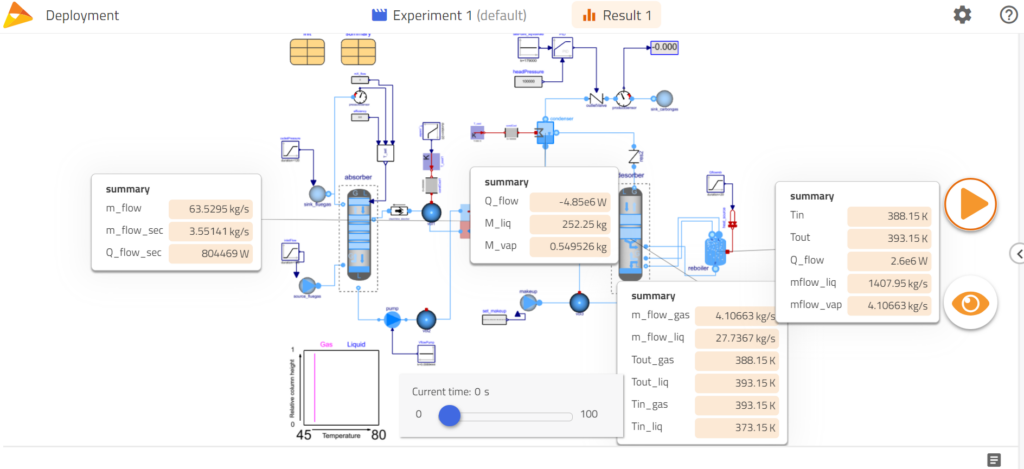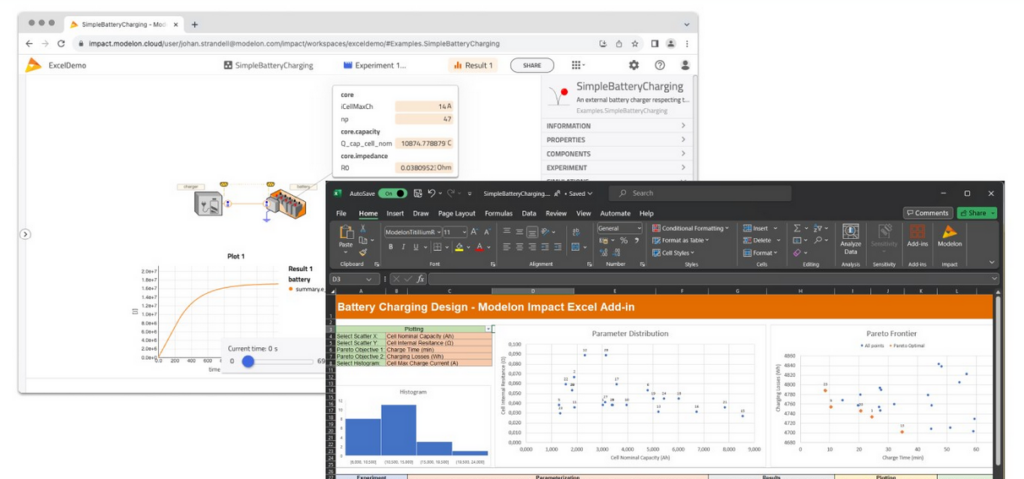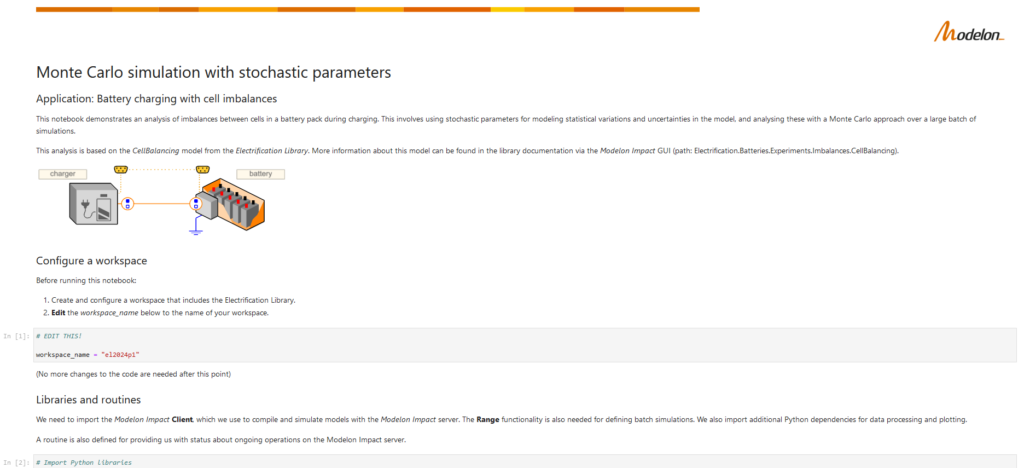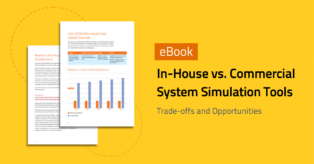デプロイとプロダクティビティのアドオン: システムモデリングとシミュレーションの効果を高める

物理システムのエンジニアリングは共同作業です。コンポーネント、プロトタイプ、制御、設計を担当するチームが連携することで、最良のシステムを提供することができます。
システムモデリングとシミュレーションソフトウェアは、エンジニアリングの意思決定を一元化し、より良い設計と運用計画を可能にします。Modelon Impactは、産業用システムをバーチャルに設計、シミュレート、解析するための信頼できるツールです。そのアドオン(追加機能モジュール)は、より多くの意思決定者を巻き込み、モデリングプロセスを合理化します。
ここでは、Modelon Impactの2つのアドオン、デプロイとプロダクティビティの機能、そしてユースケースを探ってみましょう。
デプロイアドオンとは何でしょうか?
Modelon Impactのデプロイアドオンは、チーム間でモデルを共有し、相互作用するための複数の方法を提供します。より多くのチームメンバーをシステムシミュレーションに向き合わせることは、透明性のある意思決定と生産性の向上につながります。
デプロイのユーザーは、いくつかの異なる方法でチームメンバーが開発したモデルを操作することができます。以下のアクセスポイントを利用することで、デプロイユーザーは結果を生成したり、ポスト処理したりすることができ、システム設計や性能に関する理解を深めることができます。
アプリモードでシミュレーション結果の共有
Modelon Impact Proユーザーは、アプリモードでモデルと結果をエクスポートし、デプロイユーザーとウェブリンクを介して直接共有することができます。アプリモードでは、簡素化されたUIで、デプロイユーザーが所定のパラメータを変更し、実験を実行し、結果を見ることができます。
アプリモードはシミュレーション結果を解釈し、その値をより多くの人と共有できるチームメンバーにとって、便利でしょう。デプロイユーザーはモデルのダイアグラムビューにアクセスできますが、Modelicaコードはベースユーザーまたはプロユーザーが管理します。

デプロイユーザーがアプリモードモデルをどのように活用するか、例を以下に示しています。
1. 意思決定者が、検証済みのモデルを使用して、自分で結果を生成し、レビューする。
2. 営業チームのメンバーが、見込み客の要件データを使用して、プロジェクトに対する自信を深める。
3. 制御エンジニアリングのチームが、部門の垣根を超えて業務を調整するために実験を行う。
Excelのアドインを使用したMicrosoft Excelへの接続とMicrosoft Excelからの接続
モデロンは最近、Excelアドインをリリースしました。これは、デプロイユーザーに役立ちますが、すべてのModelon Impactユーザーが利用できます。Excelアドインは、Modelon ImpactシステムシミュレーションをExcel(ブラウザ版またはデスクトップ版)で直接セットアップし、実行し、可視化することを可能にします。
数回のクリックで、Modelon ImpactからExcel実験テンプレートにモデルをエクスポートすることができます。モデルをExcelで開けば、ユーザーは以下を実行することができます。
- Excelベースのデータによるケースごとのパラメタリゼーション
- シミュレーション結果の後処理
- カスタム設定によるスイープの実行
- 迅速な要件検証
- 例えば、HVAC関連の会社は、制御チームにデプロイのライセンスを配備することができます。Modelon ImpactのパワーをExcelに導入することで、制御チームは、モデルを構築することなく、シミュレーションデータを使用して、より正確な制御戦略を設計することができます。

REST APIを使用してModelon Impactと外部ツールをリンクする
Modelon Impactは、ユーザーがModelon Impactと他のツールの間でカスタムワークフローを作成することを可能にする、文書化されたREST APIを提供しています。この接続により、ユーザーはウェブアプリを作成し、タスクを自動化し、データを視覚化することができます。
APIは、成果物の追加と抽出、メタデータへのアクセス、非同期実行をサポートしています。これらの実行には、ビルトインおよびカスタムの解析メソッドによるモデル・コンパイル、単一シミュレーション、並列シミュレーションが含まれます。REST APIの詳細については、こちらをご覧ください。
PythonクライアントでJupyter Notebookを有効にする
REST APIはPythonクライアントも有効にします。Pythonクライアントは、PythonまたはJupyterNotebookから簡単にModelon Impactと連動することを可能にします。ユーザーは、Pythonエコシステムを活用して、複数の実験をセットアップし、実行し、後処理を行うことがよくあります。

例えば、上の写真のNotebookは、充電中のバッテリパックのセル間の不均衡の分析を示しています。モデルにおける統計的変動や不確実性をモデル化するために、確率的パラメーターを使用することで、Modelon Impactのユーザーは、大規模なシミュレーションのバッチ処理によるモンテカルロ法で解析することができます。
完全なNotebookはこちらからご覧いただけます。
Pythonクライアントについては、モデロンの資料をご覧ください。
プロダクティビティアドオンとは何ですか?
Modelon Impactのプロダクティビティアドオンは、複雑なワークフローの実行をより効率的にします。
プロダクティビティアドオンを使用すると、マルチラン(複数条件での実行)実験の実行が複数のコンピューティングコアに分散され、全体的な実行時間が大幅に短縮されます。Modelon Impactはクラウドネイティブであり、クラウドインフラ上に展開されるため、このような時間短縮が可能です。
ユーザーがユーザーインターフェース内のPLAYボタンを押してマルチラン実験の実行を開始すると、対応するAPIコールが実行されます。実験はケースごとに展開され、利用可能な計算能力に応じて分散されます。
より多くのシミュレーションコアにアクセスすることで恩恵を受けるワークフローの一例として、マルチポイントキャリブレーションがあります。このワークフローは、自動車および航空宇宙産業では標準的なものですが、熱交換器をモデルに統合する場合には必ず関連する可能性があります。
Modelon Impactのユーザーは、プロダクティビティアドオンを使用して複雑なエンジニアリングワークフローを作成することがよくあります。ユーザーは、カスタムスクリプトを構築し、マルチラン実験を数時間ではなく数分で完了することができます。プロダクティビティアドオンの詳細については、こちらをご覧ください。
ボトムライン
Modelon Impactは、専門家が現行設計と実世界の機能性とのつながりを理解しやすくし、物理システムの開発コストを削減し、開発タイムラインを満たす手助けをします。 プロダクティビティとデプロイメントのアドオンにより、エンジニアリングチームのメンバーは、モデルベースの設計とシミュレーションにより効果的に取り組むことができます。
精密なシステムモデリングとシミュレーションでModelon Impactがどのように貴社のチームを支援できるのか、ぜひご相談ください。

